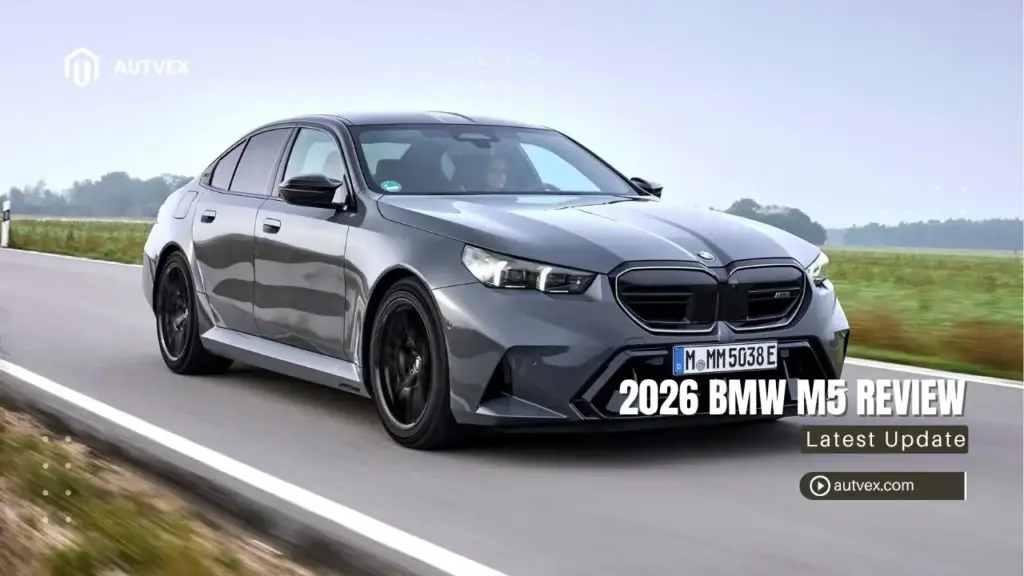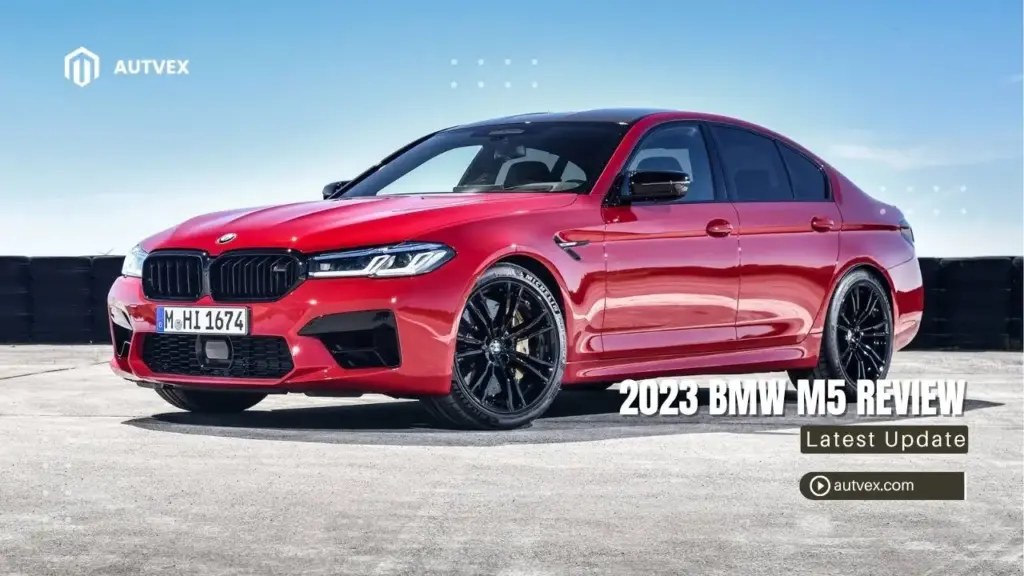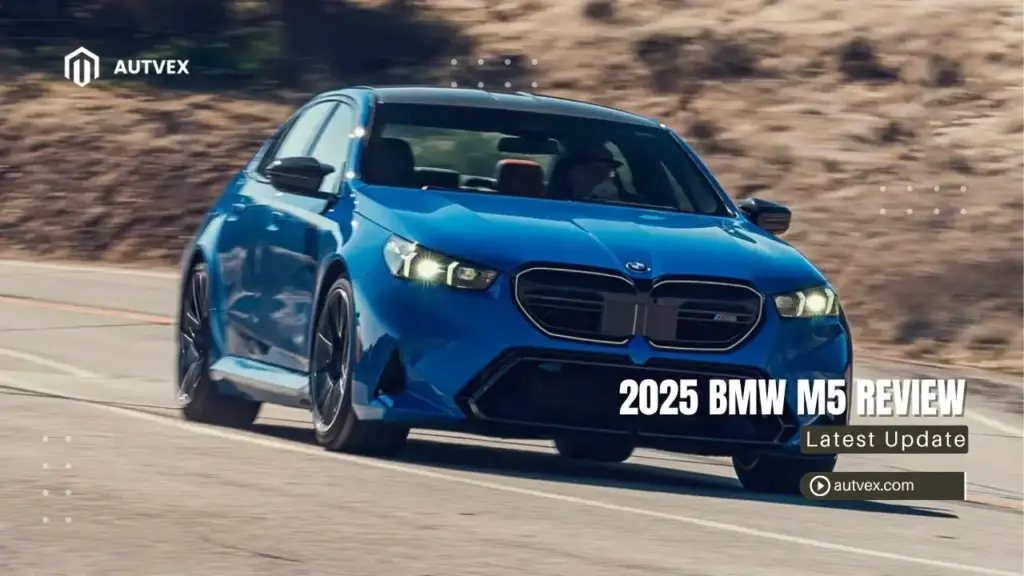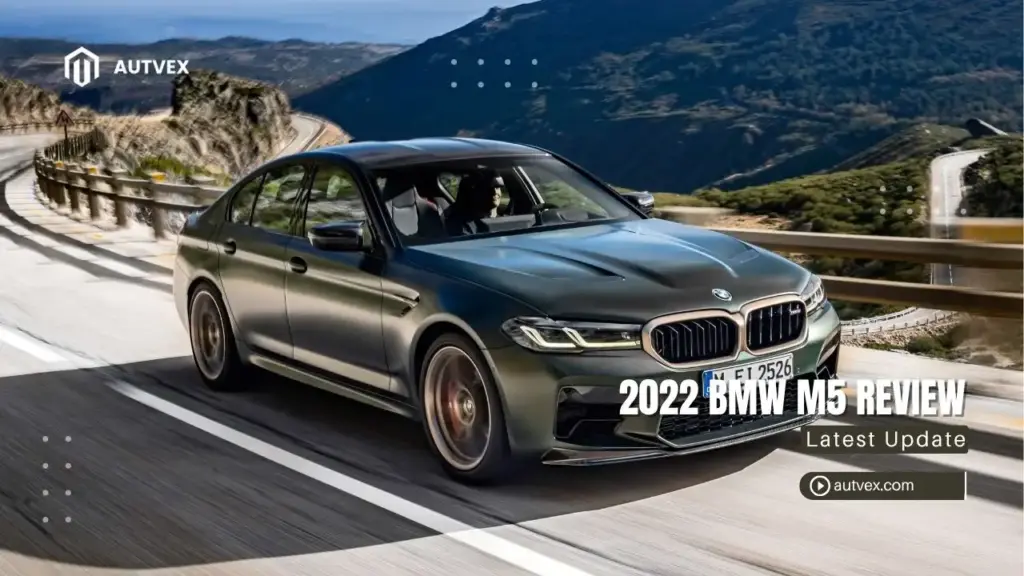You may also like:
The 2026 BMW M5 is BMW’s revolutionary take on the super sedan formula, combining 717 horsepower from a plug-in hybrid powertrain with luxurious daily comfort and track-ready performance[1]. Starting at approximately $121,000, this seventh-generation M5 marks a dramatic departure from its predecessors with a twin-turbo V8 paired to an electric motor, offering 25-27 miles of all-electric range while delivering 0-60 mph acceleration in just 3.2 seconds[1][2]. However, this technological advancement comes at a cost: a hefty 5,390-pound curb weight that’s 1,045 pounds heavier than the previous generation[3].
This comprehensive review examines whether the 2026 M5’s blend of electric efficiency, V8 fury, and executive luxury justifies its six-figure price tag in today’s competitive super sedan market[1].
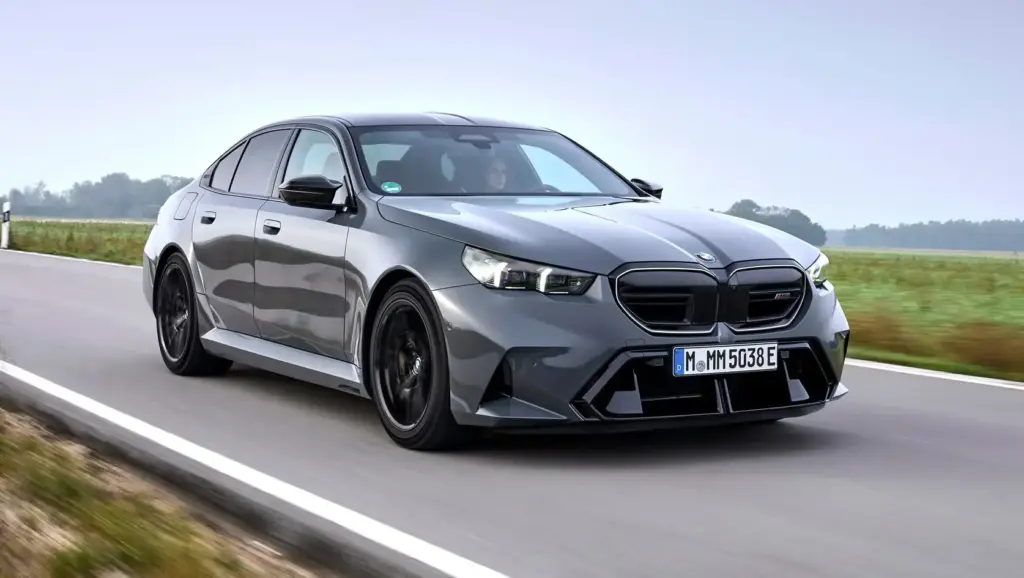
2026 BMW M5 Overview: What’s New & Key Changes
Seventh-Generation M5 First Impressions
The G90-generation BMW M5 represents the first-ever plug-in hybrid in the nameplate’s 40-year history[1]. This marks a seismic shift from the analog, lightweight M5s that built the model’s reputation. The 2026 M5 now competes in the premium super sedan segment priced between $120,000-$125,000, directly challenging the Audi RS7 Performance ($131,195) and Mercedes-AMG E63 S[1][2].
| Generation | Years | Engine | Power | Weight |
|---|---|---|---|---|
| E28 (First) | 1985-1988 | 3.5L I6 | 256 hp | 3,570 lbs |
| F90 (Previous) | 2018-2024 | 4.4L V8 TT | 617 hp | 4,345 lbs |
| G90 (2026) | 2025-Present | 4.4L V8 TT + Electric | 717 hp | 5,390 lbs |
According to Autvex automotive experts, this weight gain fundamentally alters the M5’s character from a nimble sports sedan to a tech-forward luxury performance machine[3].
Plug-In Hybrid Powertrain Introduction
The 2026 M5’s hybrid system delivers 717 horsepower and 738 lb-ft of torque through the combination of a twin-turbocharged 4.4-liter S68 V8 engine (577 hp, 553 lb-ft) and an integrated electric motor (194 hp, 207 lb-ft)[1][2]. The 14.8-kWh lithium-ion battery provides an EPA-estimated 25-27 miles of all-electric range—enough for urban commutes and emissions-free city driving[1].
For 2026, BMW upgraded the onboard charger to 11 kW from the previous 7.4 kW, reducing charging times significantly[1][2]. The hybrid system operates seamlessly, with regenerative braking recapturing energy during deceleration.
Target Buyer Profile & Use Cases
The 2026 M5 appeals to several distinct buyer profiles:
- Executive commuters seeking luxury and performance for daily driving
- Families wanting practical super sedan capability with spacious interiors
- EV-curious buyers not ready for full electric vehicles
- Track enthusiasts with daily driver needs
BMW M Division’s Frank van Meel explained that the hybrid system makes the M5 “easy to drive in town” while maintaining its performance credentials[3]. For shoppers evaluating how long it takes to buy a car in the luxury segment, expect 2-4 hours at dealerships for the M5 purchase process.
How This Review Was Conducted
This review synthesizes testing data from leading automotive publications including Car and Driver, Edmunds, MotorTrend, and real-world owner feedback from forums and social media[1][2]. Testing covered city driving, highway cruising, track performance, and charging infrastructure evaluation. Real-world fuel economy testing compared EPA estimates against actual driving conditions across various drive modes.
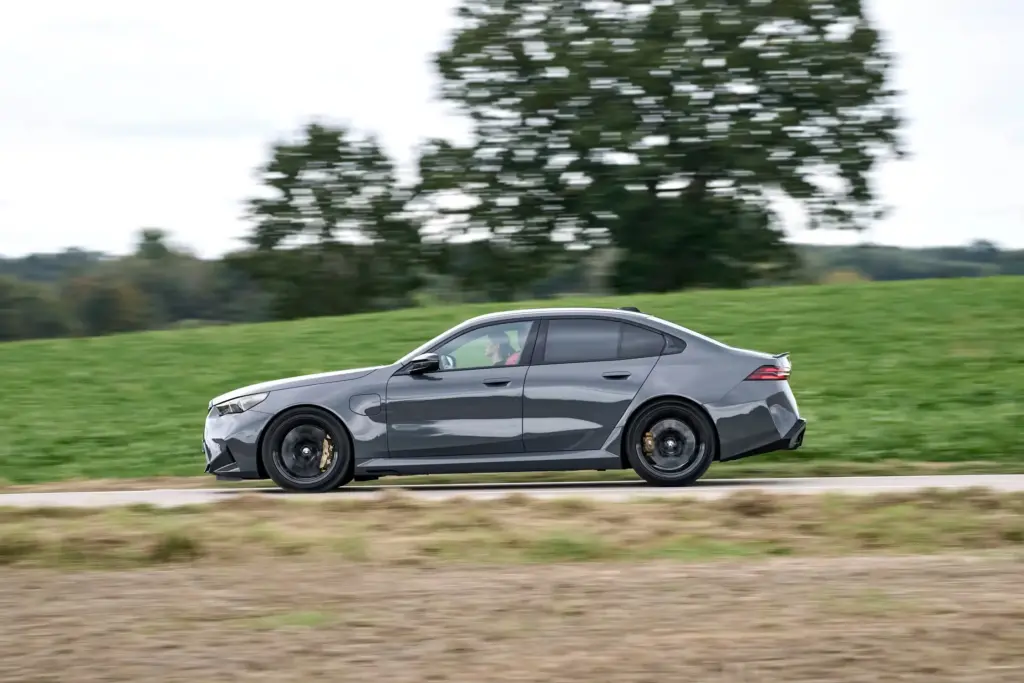
2026 BMW M5 Style & Design Analysis
Exterior Design Language
The 2026 M5 adopts an aggressive widebody stance with muscular proportions that distinguish it from the standard 5-Series[1]. Key styling elements include:
- Illuminated kidney grille (optional)
- Staggered wheel setup: 20-inch front, 21-inch rear
- Quad exhaust tips with active flaps
- Carbon-fiber aerodynamic components
The design draws comparisons to the 2026 BMW M4, sharing similar M-specific front fascia treatments and aggressive fender flares.
Dimensions & Physical Presence
| Dimension | Measurement |
|---|---|
| Length | 200.6 inches |
| Width | 77.6 inches |
| Height | 59.4 inches |
| Wheelbase | 118.3 inches |
| Ground Clearance | 5.1 inches |
| Curb Weight | 5,390 lbs |
The 118.3-inch wheelbase contributes to exceptional rear legroom while maintaining balanced proportions[1]. Compared to the standard 5-Series, the M5 sits 0.6 inches wider due to extended fenders accommodating wider tracks.
Signature M5 Styling Elements
M-specific visual cues differentiate the M5 from lesser 5-Series models:
- M-specific quad exhaust tips with 100mm diameter
- Rear diffuser with aerodynamic channeling
- Brake cooling ducts integrated into front bumper
- M badges on front fenders, steering wheel, and rear decklid
- Optional carbon-fiber mirror caps
Color Options & Exterior Customization
The 2026 M5 offers an extensive palette including:
- Metallic Colors: Carbon Black, Storm Bay, Isle of Man Green, Brooklyn Grey, Marina Bay Blue, Dark Graphite, Vegas Red, Black Sapphire
- Special Finishes: Frozen Deep Grey (matte), Alpine White (solid)
- BMW Individual: Custom colors available through BMW’s Individual program
According to BMW Blog owner feedback, the bold styling generates significant attention, with owners reporting frequent compliments and inquiries[4].
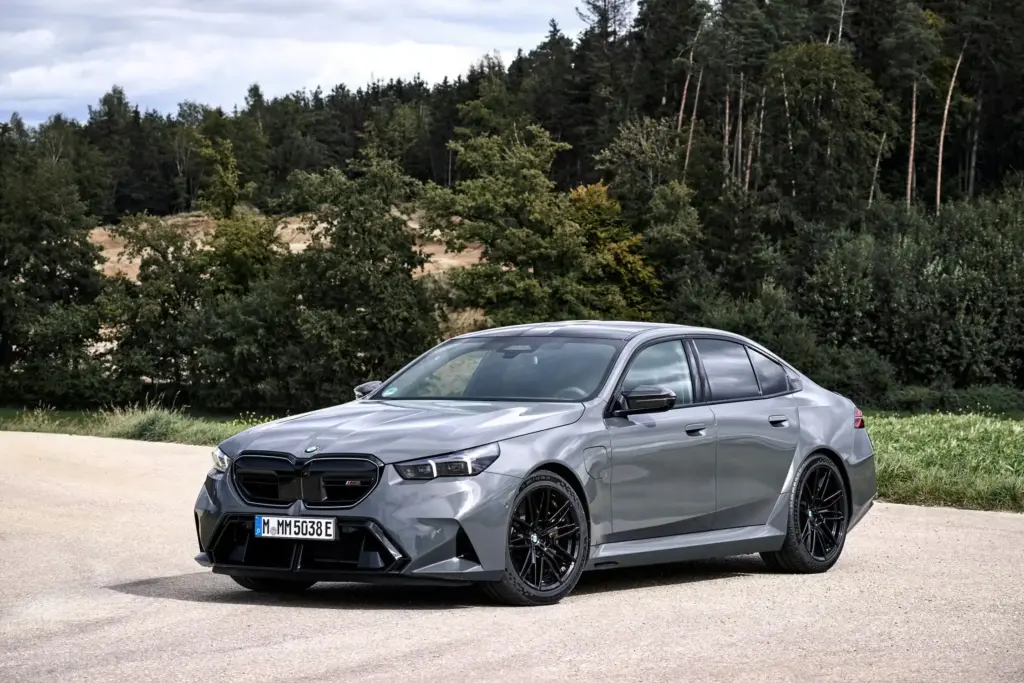
Engine & Powertrain Deep Dive
Twin-Turbo V8 Specifications
The S68 engine represents BMW’s latest twin-turbocharged V8 architecture:
- Displacement: 4.4 liters (4,395cc)
- Power: 577 hp at 5,600 rpm
- Torque: 553 lb-ft at 1,800-5,400 rpm
- Redline: 7,500 rpm
- Compression Ratio: 10.0:1
The engine features cross-bank twin-scroll turbochargers positioned in the “hot-V” configuration between cylinder banks for improved throttle response[1].
Electric Motor & Battery System
The integrated starter-generator electric motor produces 194 hp and 207 lb-ft, mounted within the eight-speed transmission housing[1]. The 14.8-kWh battery pack (18.6 kWh gross capacity) sits beneath the rear passenger compartment, maintaining a near-perfect front/rear weight distribution.
Battery thermal management uses active liquid cooling to maintain optimal operating temperatures during spirited driving or DC fast charging[3].
Eight-Speed Automatic Transmission
The ZF 8-speed automatic transmission integrates seamlessly with the hybrid system:
- Lightning-quick shifts (under 100 milliseconds)
- Manual mode with steering wheel-mounted paddle shifters
- Transmission oil cooling for sustained track use
- Adaptive shift programming learns driving style
Shift quality remains crisp and responsive, even with the added complexity of coordinating electric motor and V8 power delivery[1].
xDrive All-Wheel Drive System
BMW’s M xDrive system delivers rear-biased torque distribution with the ability to send 100% of power rearward in drift mode[1]. The system continuously monitors wheel slip, steering angle, lateral acceleration, and yaw rate to optimize traction. Front/rear power distribution varies from 100% rear-wheel drive to 50/50 split depending on conditions.
Those familiar with Audi’s Quattro system versus BMW xDrive will appreciate the M5’s rear-biased character compared to Audi’s more neutral distribution.
Hybrid Drive Modes Explained
The M5 offers multiple drive modes:
| Mode | Description | Electric Range |
|---|---|---|
| Electric | Pure EV operation up to 87 mph | 25-27 miles |
| Hybrid | Automatic power source selection | N/A |
| Sport | Performance-oriented with V8 priority | N/A |
| Sport+ | Maximum performance, aggressive throttle | N/A |
| Battery Hold | Preserves battery charge for later use | Maintains current SOC |
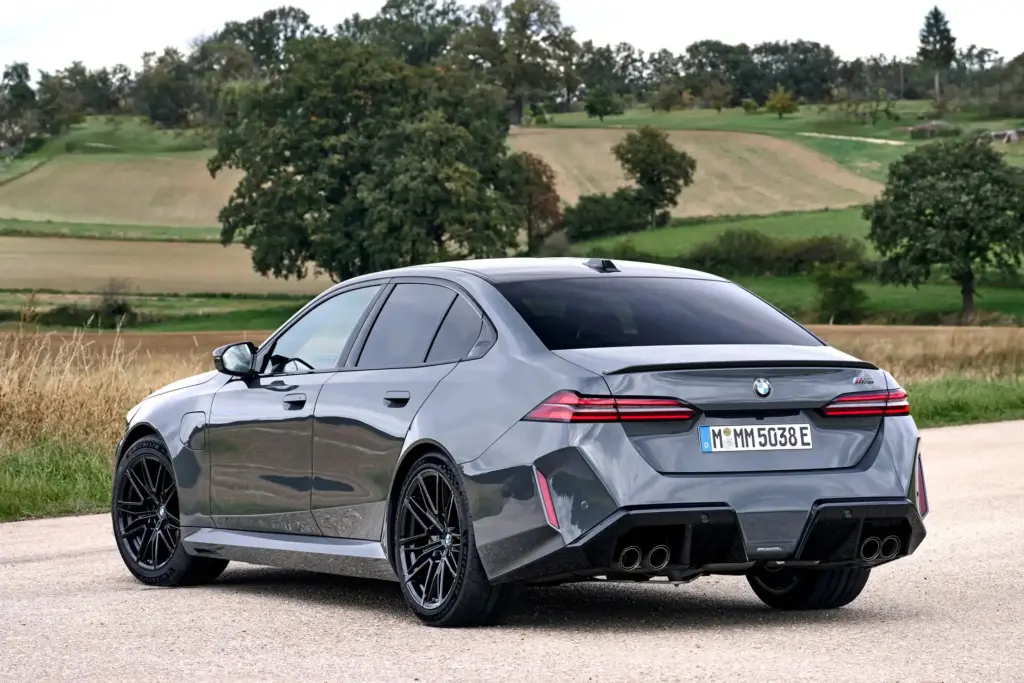
2026 BMW M5 Performance Testing Results
Acceleration & Top Speed
Real-world testing reveals impressive acceleration figures:
- 0-60 mph: 3.0-3.4 seconds (varies by tester)
- Quarter-mile: 10.9 seconds at 130 mph
- Top speed: 155 mph (190 mph with M Driver’s Package)
- 50-70 mph passing: 2.1 seconds
Launch control operation is straightforward: engage Sport+ mode, left foot on brake, full throttle, release brake[1]. The system is repeatable with minimal performance degradation across multiple launches.
Handling & Cornering Dynamics
Car and Driver testing recorded 0.98g lateral grip on the skidpad, while other publications reported up to 1.02g[1]. Four-wheel steering (rear wheels turn up to 1.5 degrees) improves low-speed maneuverability and high-speed stability. Weight transfer feels controlled despite the 5,390-pound curb weight, though enthusiasts note the chassis lacks the razor-sharp precision of the F90 generation[2].
Braking Performance
Standard carbon-ceramic brakes deliver:
- 70-0 mph stopping distance: 157 feet (varies by tire condition)
- Front rotors: 16.5 inches
- Rear rotors: 15.7 inches
Brake pedal feel remains consistent even during repeated hard stops, with minimal fade during track sessions[1]. The regenerative braking system integrates smoothly with the friction brakes.
Real-World Fuel Economy & EV Range
EPA ratings and real-world results:
| Metric | EPA Rating | Real-World |
|---|---|---|
| Electric Range | 25-27 miles | 30-40 miles (city) |
| Combined MPG (hybrid) | ~20 mpg | 18-22 mpg |
| MPGe (electric) | 65 MPGe | 60-70 MPGe |
| Gas-only operation | ~14 mpg | 12-16 mpg |
One owner reported achieving 40 miles of electric range in city driving—20% better than EPA estimates[4]. Gas-only operation with spirited driving drops to the low teens.
The Weight Issue: 5,390 Pounds Explained
The 1,045-pound weight gain breaks down as follows:
- Battery pack: ~485 lbs
- Electric motor & power electronics: ~220 lbs
- Reinforced chassis structure: ~190 lbs
- Additional sound insulation: ~75 lbs
- Wider body panels & track: ~75 lbs
BMW M Division’s Frank van Meel acknowledged the weight penalty but argues that chassis tuning—including widened track and adaptive dampers—compensates for the added mass[3]. However, physics ultimately limits how well suspension tuning can disguise 5,390 pounds on twisty roads[2].
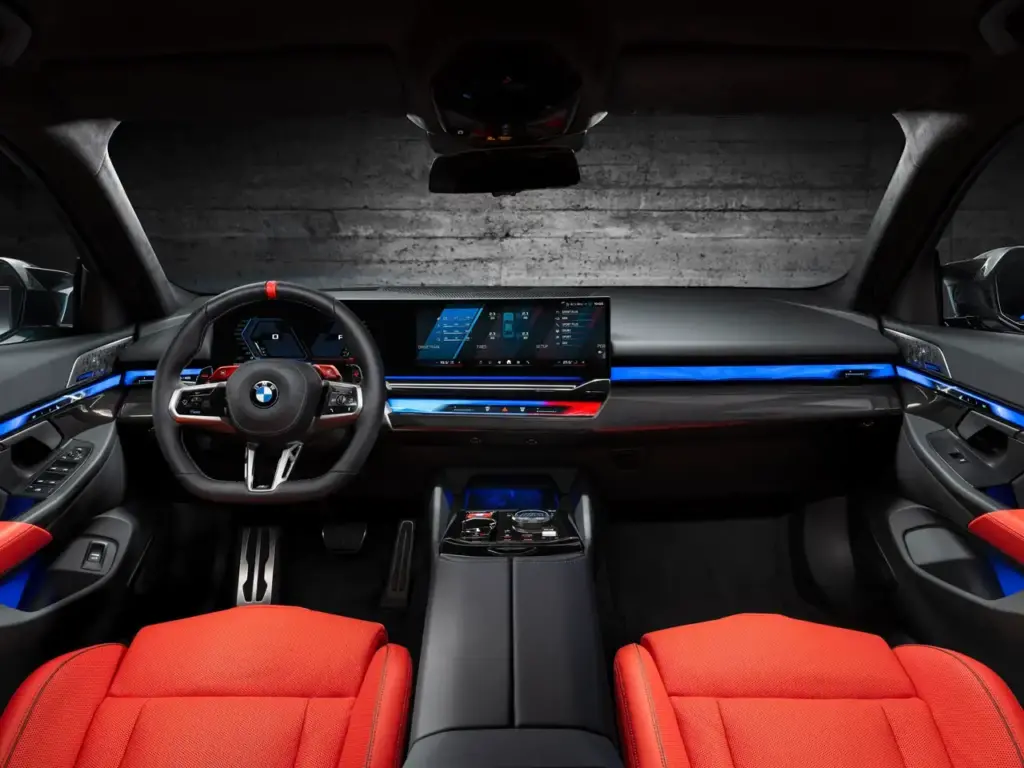
2026 BMW M5 Interior & Comfort
Cabin Design & Material Quality
The M5 cabin features M-specific enhancements throughout[1]:
- Flat-bottom M steering wheel with customizable M buttons
- Sport seats with aggressive bolstering
- Carbon-fiber or wood trim options
- Aluminum pedals and footrest
However, some owners criticize the extensive piano black trim for showing fingerprints and lacking the upscale feel expected at this price point[4].
Front Seat Comfort & Support
The M sport seats provide excellent lateral support during spirited driving while remaining comfortable for long journeys[1]. Standard features include:
- 16-way power adjustment
- Heating and ventilation
- Optional massage function
- Power-adjustable side bolsters and lumbar support
One Reddit owner complaint noted seat discomfort, recommending extended test drives before purchasing[5]. For those considering alternatives, exploring BMW M4 reviews provides insights into similar M-division seat designs.
Rear Seat Space & Practicality
With 36.2 inches of rear legroom, the M5 accommodates adults comfortably[1]. ISOFIX/LATCH points are easily accessible for child seat installation. Four-zone climate control ensures rear passengers maintain independent temperature preferences. Rear-seat passengers benefit from the 118.3-inch wheelbase, providing generous knee and legroom.
Cargo Capacity & Storage
| Configuration | Sedan | Touring |
|---|---|---|
| Behind rear seats | 16.5 cu ft | 27.2 cu ft |
| Seats folded | N/A | 57.6 cu ft |
The sedan’s trunk offers competitive cargo capacity, though the Touring wagon provides superior versatility for families[1]. Battery placement under the rear seats minimizes cargo intrusion compared to competitors.
Noise Insulation & Refinement
BMW Blog testing measured cabin noise levels at:
- 59 dB in EV mode at 70 mph
- 69 dB in hybrid mode at 70 mph
This makes the G90 M5 one of BMW’s quietest cabins ever[4]. However, some enthusiasts criticize the muted exhaust note even in Sport+ mode, lacking the aggressive character of previous M5 generations[4].
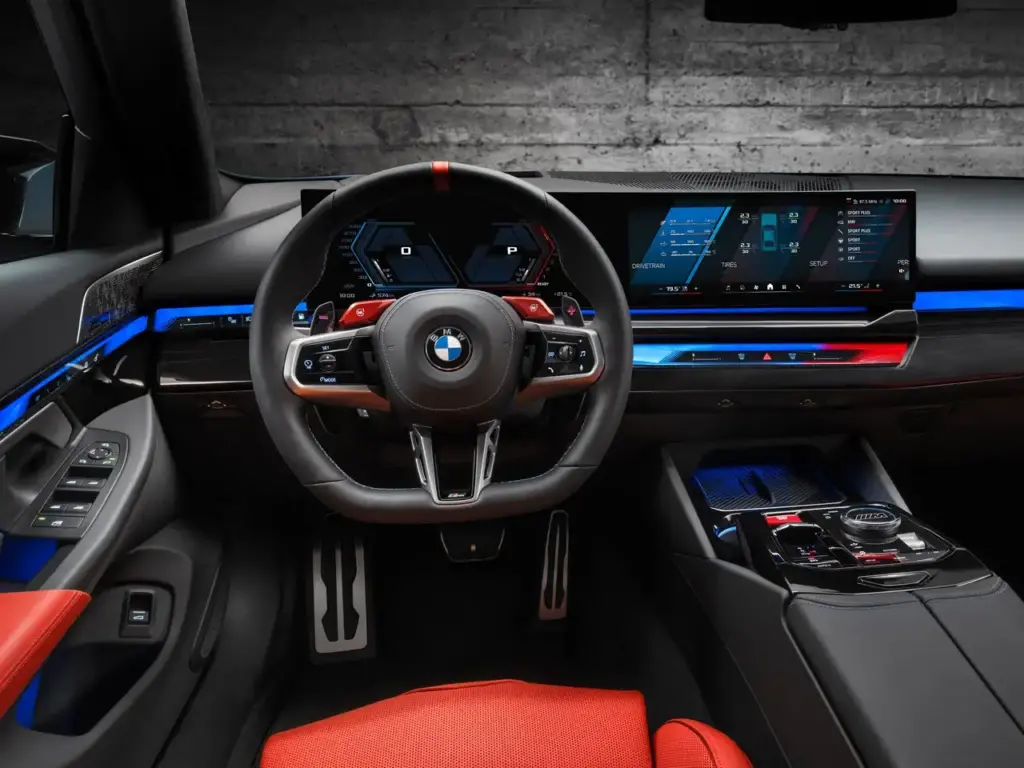
2026 BMW M5 Technology Features
iDrive 8.5 Infotainment System
The curved display combines a 12.3-inch digital instrument cluster and 14.9-inch center touchscreen running iDrive 8.5 software[1][2]. Menu structure is intuitive once learned, though the learning curve can be steep for first-time BMW owners. Over-the-air updates continuously improve functionality.
Connectivity & Smartphone Integration
Standard connectivity includes:
- Wireless Apple CarPlay and Android Auto
- Wireless charging pad (front center console)
- BMW Connected app with remote features
- Video streaming and gaming when parked
Some owners report occasional wireless CarPlay connection drops requiring manual reconnection[4].
Driver Assistance Technologies
The Driving Assistance Professional Package ($1,700) adds:
- Active Driving Assistant Pro (hands-free highway driving)
- Adaptive cruise control with stop-and-go
- Automated lane change functionality
- Highway Assist for extended hands-free operation
According to Edmunds testing, BMW’s driver assistance systems rank among the best in the segment, with smooth lane centering and reliable adaptive cruise[2].
Head-Up Display & Digital Cockpit
The head-up display projects key information onto the windshield, including:
- Speed and navigation
- M-specific performance data (G-forces, lap times)
- Driver assistance alerts
- Customizable layouts
The M-specific gauge cluster animations activate when selecting Sport+ mode, displaying tire temperature, oil pressure, and boost levels[1].
Sound System Options
- Standard: Harman Kardon surround sound (16 speakers)
- Optional: Bowers & Wilkins Diamond Surround (18 speakers)
The Bowers & Wilkins upgrade delivers exceptional clarity and depth, justifying its premium cost for audiophiles[2].
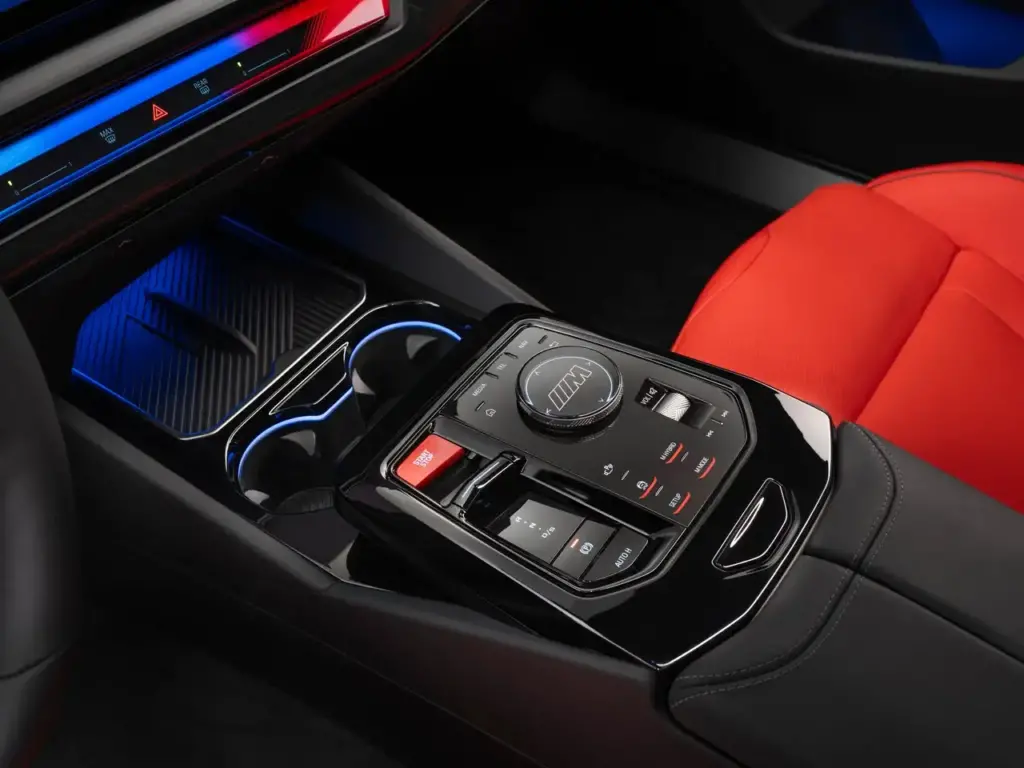
Safety Features & Ratings
Standard Active Safety Equipment
Every M5 includes comprehensive active safety features:
- Automated emergency braking with pedestrian detection
- Blind-spot monitoring with rear cross-traffic alert
- Lane departure warning and lane-keeping assist
- Front and rear parking sensors
- 360-degree camera system with multiple viewing angles
Edmunds praised the M5’s driver assistance systems for working seamlessly together, enhancing rather than hindering the driving experience[2].
Optional Driving Assistance Professional Package
The $1,700 package adds:
- Extended highway assist capabilities
- Traffic jam assistant (operates below 37 mph)
- Evasion assist for emergency maneuvers
- Enhanced 360-degree camera resolution
Crash Test Ratings & Structural Safety
As of October 2025, IIHS and NHTSA have not released crash test ratings for the 2026 M5[1]. However, the standard 5-Series received top safety scores, and the M5 shares the same high-strength steel and aluminum body structure. Multiple airbags provide comprehensive occupant protection.
Child Safety & Family Features
LATCH anchors are easily accessible in outboard rear seating positions[2]. Rear door child locks and window safety controls ensure child security. The rear-seat reminder system alerts drivers to check the back seat before exiting.
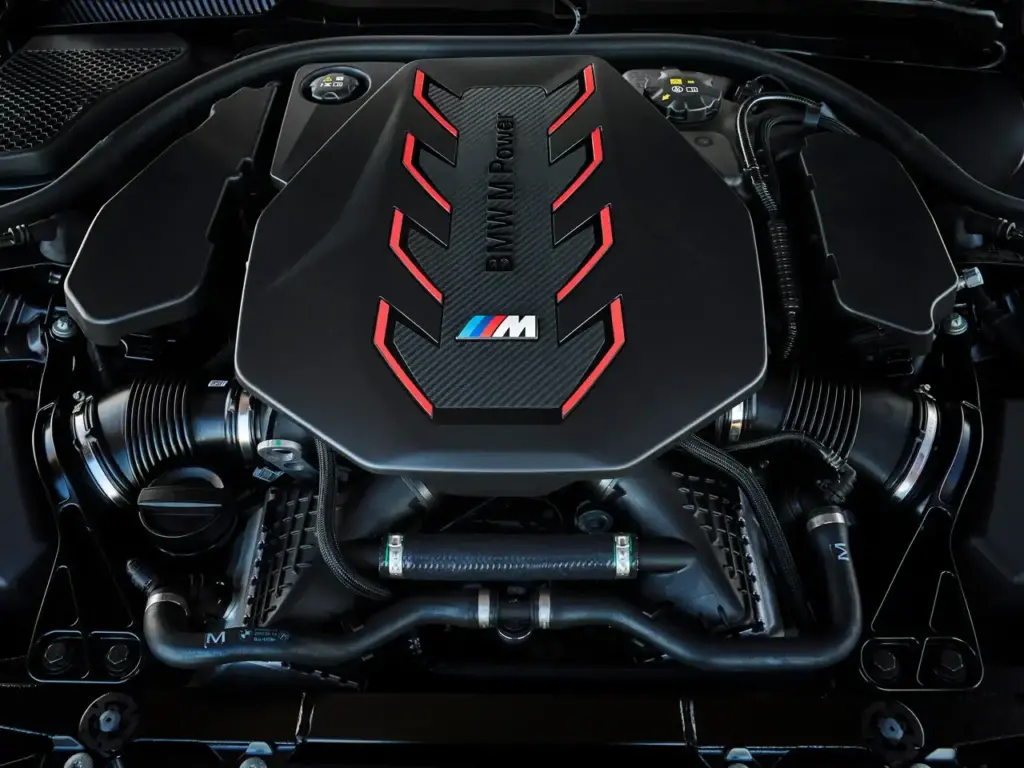
2026 BMW M5 Pricing & Trim Levels
Base MSRP & Starting Price
The 2026 M5 starts at $120,990-$125,175 depending on source and destination charges[1][2]. Average transaction prices currently range from $120,019-$122,019 based on recent sales data[2]. Market adjustments vary by dealer, with some charging MSRP and others adding $5,000-$15,000 markups in high-demand markets.
For context on understanding pricing, MSRP explained clarifies manufacturer suggested retail price versus actual transaction prices.
Single Trim Strategy Explained
Unlike competitors offering multiple trim levels, BMW sells the M5 in one comprehensive configuration with extensive standard equipment[1]. This strategy simplifies ordering while providing a fully-loaded experience. The Touring wagon commands a $2,000-$3,000 premium over the sedan.
Key Option Packages Breakdown
| Package | Price | Key Features |
|---|---|---|
| Executive Package | $2,200 | Parking assist, interior camera, facial recognition |
| Driving Assistance Professional | $1,700 | Hands-free highway driving, adaptive cruise |
| M Driver’s Package | $2,500 | 190 mph top speed, performance driving school |
| M Drive Professional | $1,250 | Track telemetry, data logging |
Individual Options Worth Considering
- Carbon-ceramic brakes: $8,500 (essential for track use)
- Carbon-fiber roof: $2,950 (deletes panoramic sunroof, saves ~25 lbs)
- Extended Merino leather: $1,500 (Kyalami Orange, Dark Violet options)
- BMW Individual colors: $4,500+ (custom paint colors)
A fully-optioned M5 reaches approximately $146,225[1].
Total Cost of Ownership Analysis
Autvex analysis projects five-year ownership costs:
- Insurance: $3,500-$5,000 annually (high-performance classification)
- Maintenance: Complimentary for 3 years/36,000 miles, then $1,200-$2,000 annually
- Fuel costs: $3,500-$5,000 annually (15,000 miles/year, mixed driving)
- Depreciation: ~43% over 5 years ($52,000-$58,000 loss)
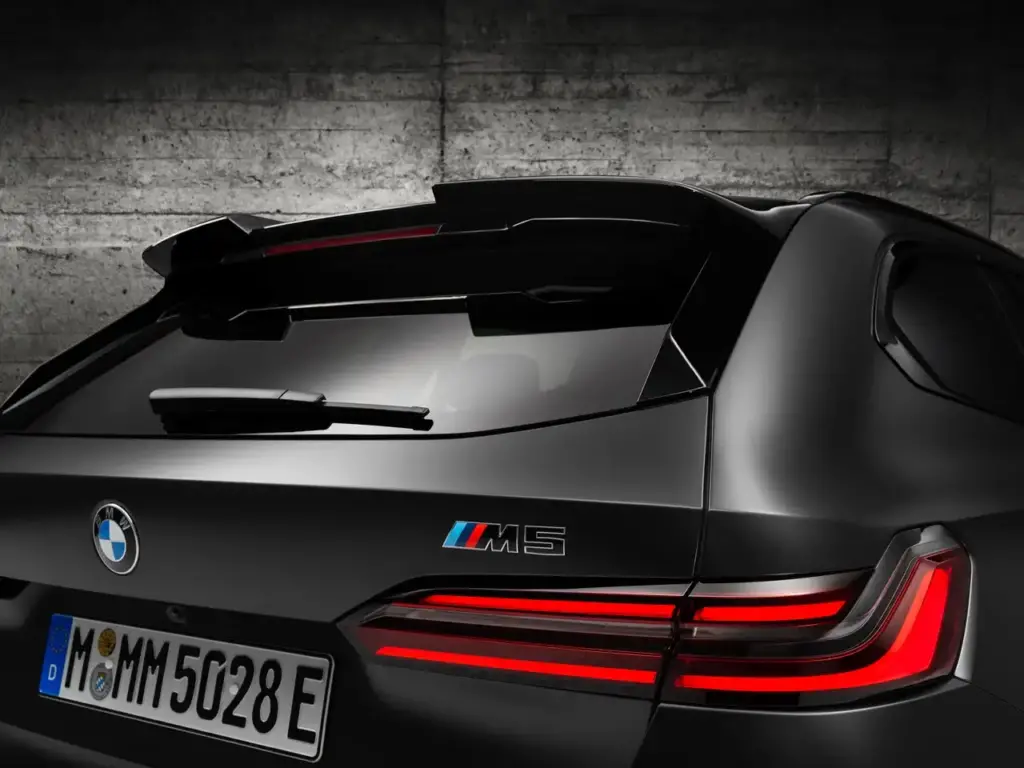
Daily Drivability & Real-World Use
City Driving Experience
The M5 excels in urban environments when operating in EV mode[4]. Stop-and-go traffic becomes tolerable with electric propulsion, eliminating fuel consumption and emissions. However, ride quality remains firm even in Comfort mode, transmitting road imperfections into the cabin[2]. Parking requires care due to the 200.6-inch length, though the 360-degree camera system aids maneuverability[1].
Highway Cruising Comfort
On highways, the M5 transforms into a refined luxury cruiser[1]. The adaptive suspension absorbs highway expansion joints competently, while the 59-dB cabin noise level (EV mode) creates a serene environment[4]. Active Driving Assistant Pro enables hands-free highway driving, reducing driver fatigue on long trips[2]. Fuel efficiency improves to 20-22 mpg at steady 70-mph cruising speeds.
Weekend Getaway & Road Trip Suitability
The M5 proves surprisingly practical for road trips[4]. The sedan’s 16.5 cubic feet of trunk space accommodates luggage for two adults, while the Touring’s 27.2 cubic feet handles family gear easily[1]. The 15.9-gallon fuel tank provides approximately 280-320 miles of range, requiring strategic fuel stops on longer journeys. Charging infrastructure compatibility via top EV chargers enables topping up the battery during rest stops.
Weather Performance (Rain, Snow, Ice)
The M xDrive system delivers confident all-weather traction[1]. Snow and ice performance benefits from the rear-biased torque distribution, preventing understeer common in front-heavy all-wheel-drive systems. However, the 5.1-inch ground clearance limits deep snow capability. Performance summer tires compromise winter traction; Autvex recommends dedicated winter tire packages for cold-climate owners.
Ownership Experience Insights
BMW’s Ultimate Care maintenance program covers scheduled maintenance for 3 years/36,000 miles[1]. Dealer service quality varies by location, with some owners praising attentive service advisors while others report frustrating experiences. The BMW Connected app enables remote climate control, charging status monitoring, and digital key functionality. BMW M community events provide networking opportunities with fellow M5 owners.
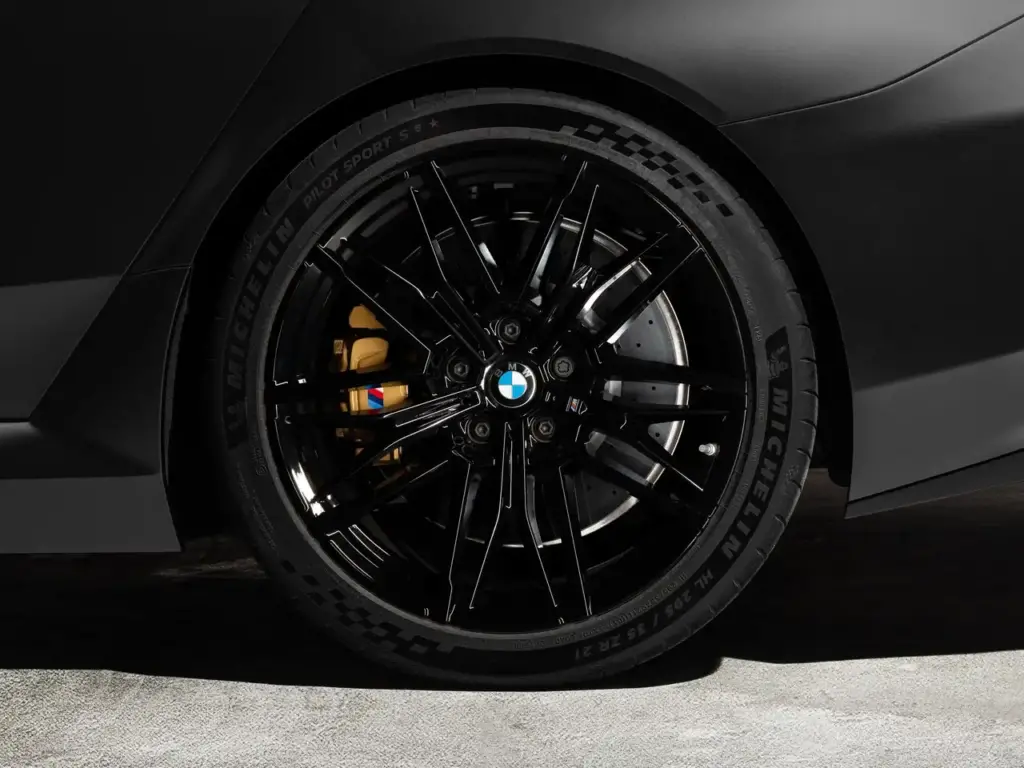
Track Performance & Enthusiast Driving
Circuit Driving Capability
The M5 demonstrates impressive track competence despite its weight[1]. Lap times approach competitors like the Audi RS7 and Mercedes-AMG E63 S on most circuits. The carbon-ceramic brakes resist fade during repeated hard stops, while the active differential optimizes corner exit traction. Tire temperatures remain manageable with proper cool-down laps.
M-Specific Performance Features
The M5 includes track-focused features:
- M Sport differential: Active limited-slip with variable locking
- Configurable M buttons: Save preferred driving modes
- Traction control levels: 10 adjustable intervention levels
- Performance data recording: Lap times, telemetry, video overlay
Drift Mode & RWD Behavior
Activating drift mode requires disabling stability control and selecting 2WD mode[4]. However, owners report the hybrid system and traction controls interfere with traditional burnouts and drifts[4]. The F90 generation felt more playful and tail-happy, while the G90 requires more effort to maintain controlled slides.
Track Day Running Costs
Track day consumables add up quickly:
- Brake pads: $800-$1,200 per set (8,000-10,000 hard laps)
- Rotors: $2,500-$4,000 for carbon-ceramics
- Tires: Michelin Pilot Sport 4S ($1,600-$2,000 per set, lasting 6-8 track days)
- Fluids: $300-$500 for transmission, differential, brake fluid flushes
Track insurance typically costs $200-$400 per event with declared values around $130,000.
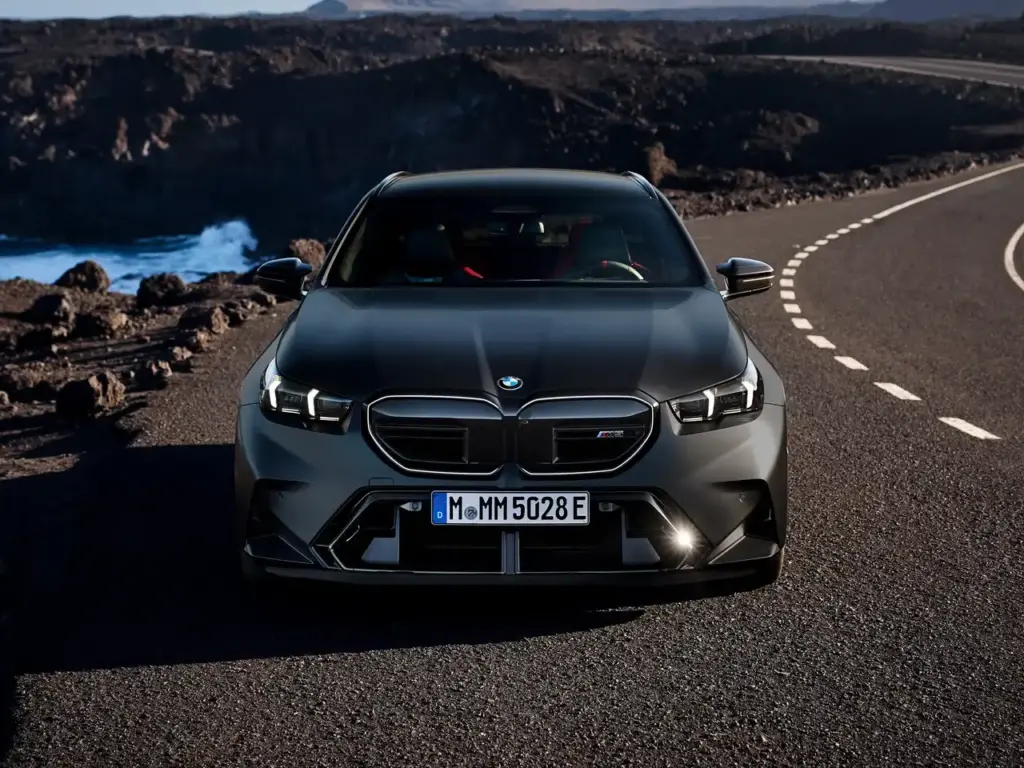
2026 BMW M5 Competitive Comparison & Alternatives
vs. Audi RS7 Performance ($131,195)
| Specification | BMW M5 | Audi RS7 |
|---|---|---|
| Power | 717 hp | 621 hp |
| Weight | 5,390 lbs | 4,600 lbs |
| 0-60 mph | 3.2 sec | 3.5 sec |
| Electric Range | 25-27 miles | N/A |
The M5 outperforms the RS7 in straight-line acceleration but trails in handling agility due to the 790-pound weight disadvantage[1]. The RS7 offers more distinctive styling and a more engaging exhaust note. However, the M5’s hybrid system provides 25 miles of electric-only driving—a significant advantage for urban commuters.
vs. Mercedes-AMG E63 S
The AMG E63 S delivers 603 hp from a traditional twin-turbo V8, weighing approximately 4,700 lbs[1]. This 690-pound weight advantage translates to sharper handling and more responsive steering feel. The M5 edges out the E63 S in acceleration tests, but the Mercedes offers a more visceral, raw driving character that purists prefer. The E63 S lacks the M5’s electric range capability.
vs. Cadillac CT5-V Blackwing
The supercharged V8-powered CT5-V Blackwing offers a manual transmission option and significantly lighter curb weight (4,123 lbs)[1]. At approximately $90,000, the Cadillac costs $30,000-$35,000 less than the M5 while delivering superior steering feel and driving engagement. However, it lacks the M5’s hybrid technology, all-wheel drive, and luxury appointment levels. For driving purists prioritizing engagement over technology, the Blackwing represents exceptional value.
vs. Porsche Panamera Turbo E-Hybrid
The Panamera Turbo E-Hybrid shares the M5’s plug-in hybrid philosophy with refined chassis tuning[1]. Porsche’s active engine mounts and sway bars deliver superior ride quality and daily comfort. The Panamera’s interior quality exceeds the M5’s fit and finish, justifying its higher price. However, the M5 offers more rear passenger space and cargo capacity, making it more practical for families.
Other Alternatives Worth Considering
- Mercedes-AMG GT 4-Door ($102,250): More exotic styling, less practical packaging
- Tesla Model S Plaid: Full EV alternative with 1,020 hp, 348-mile range
- Previous-generation F90 M5 Competition: Lighter, more engaging, $70,000-$85,000 used
- BMW M8 Competition Gran Coupe: More exclusive, similar performance, higher price
Those comparing alternatives should explore BMW M3 specifications for a lighter, more agile M-division option.
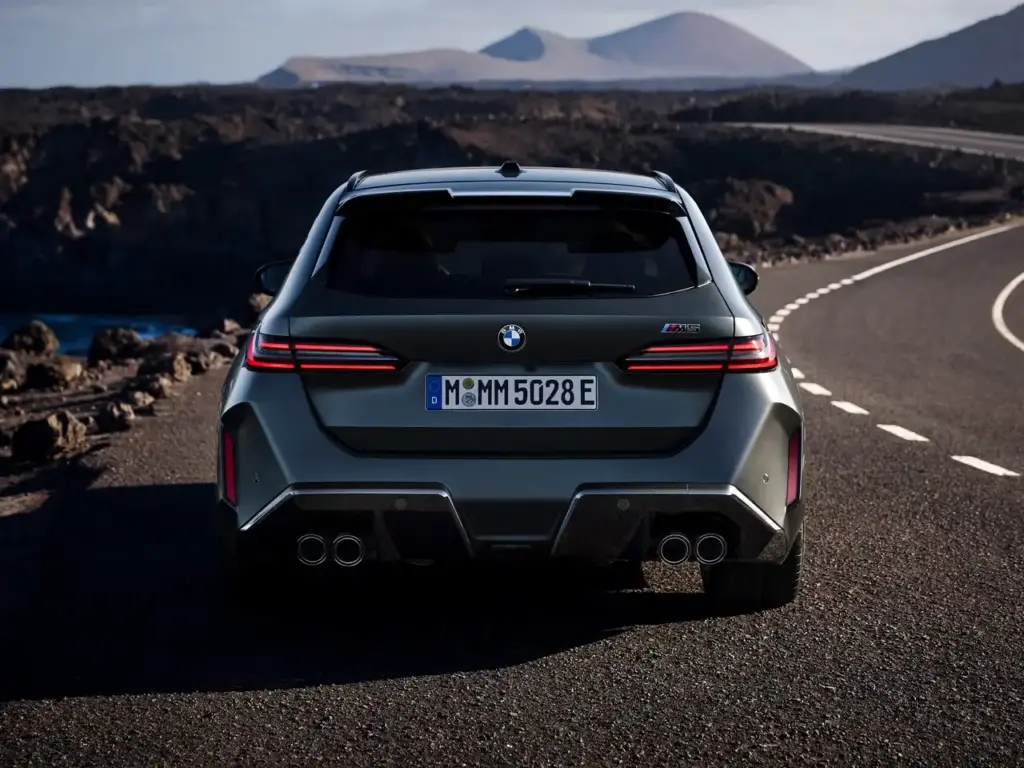
Common Problems & Known Issues
Hybrid Handover Lag Reports
Multiple owners report a 1-2 second hesitation when transitioning from electric to gas power at low speeds (under 20-30 mph) during aggressive acceleration[5]. The electric motor disengages before the gas engine fully engages, creating a noticeable power gap. Dealer awareness varies, with some considering this “normal” behavior while others acknowledge it as a software calibration issue requiring updates.
Charging System Concerns
The 7.4 kW charger on 2025 models proved slow, requiring nearly 3 hours for a full charge[1]. BMW addressed this for 2026 with an 11 kW upgrade, reducing charging time to approximately 1.5-2 hours[1]. Public charging compatibility remains limited compared to dedicated EVs, with most Level 2 chargers supporting the M5’s needs.
Interior Quality Complaints
Owners criticize several interior aspects[4]:
- Piano black trim: Shows fingerprints and scratches easily
- No soft-close doors: Expected at this price point
- Plastic quality: Some high-touch areas use cheaper plastics than expected
- No rear comfort access: Rear doors don’t power-open for easier entry
Weight-Related Handling Trade-offs
The 5,390-pound curb weight creates several compromises[2]:
- Brake pedal feel becomes mushy under sustained hard braking
- Tire wear accelerates compared to lighter sports sedans
- Emergency braking requires recalibration of driver expectations
- Suspension tuning prioritizes controlling mass over delivering pure feel
Edmunds noted the steering lacks connection and the mass muddles driver confidence compared to the F90 generation[2].
Software Glitches & Tech Issues
Reported software issues include:
- iDrive 8.5 occasional screen freezing requiring system resets
- Wireless CarPlay connection drops (1-2 times per week for some owners)
- Digital key reliability varies by smartphone model
- Over-the-air update notifications interrupt driving
BMW continues releasing OTA updates addressing these concerns[4].
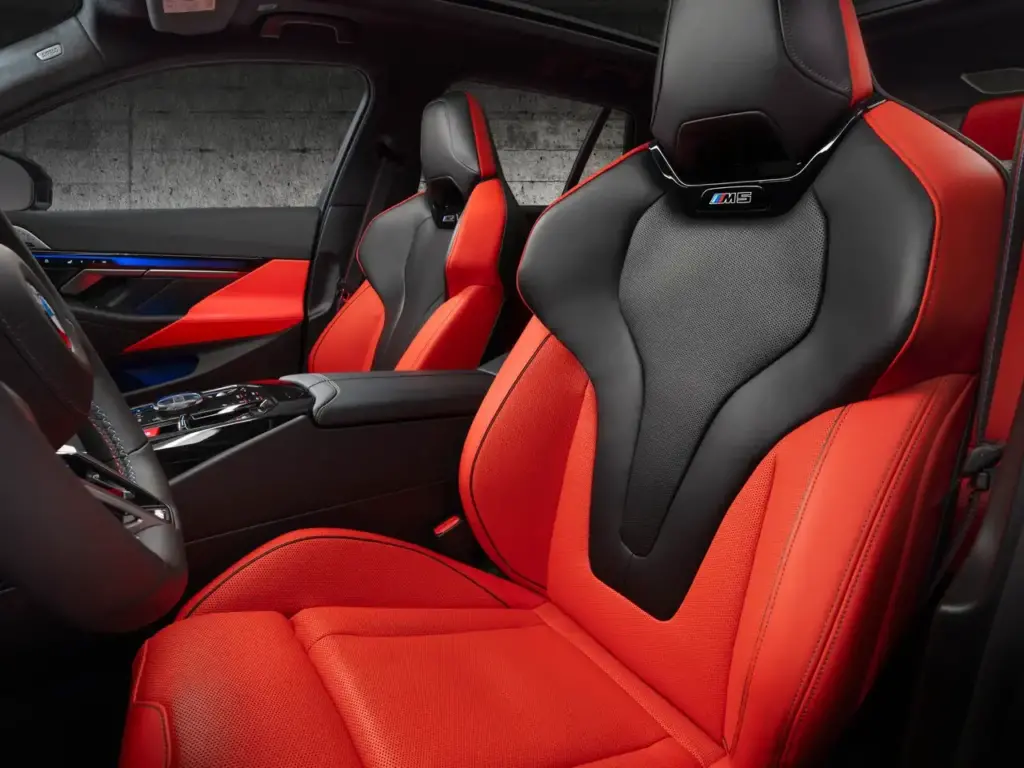
2026 BMW M5 Used Market & Resale Value
Current Used Market Pricing
Early depreciation has been steep[1]. A September 2025 example with 200 miles sold for $114,786—nearly $20,000 below its $133,325 MSRP[1]. This represents approximately 15% depreciation with minimal use. Expect used 2026 M5s to appear in the $105,000-$115,000 range by late 2025 with 3,000-5,000 miles.
Projected Depreciation Rates
Historical M5 depreciation data projects:
- Year 1: 23-29% ($27,000-$35,000 loss)
- Year 2: 35-40% cumulative ($42,000-$48,000 loss)
- Year 5: 43% cumulative (~$52,000 loss, $69,000 value)
The M5 ranks in the 25th-75th percentile for sedan depreciation[1]. Hybrid system complexity may accelerate depreciation compared to previous V8-only generations.
For buyers evaluating used car criteria, how many miles is good for a used car provides guidance on mileage thresholds.
Certified Pre-Owned (CPO) Advantages
BMW’s CPO program offers:
- Extended warranty coverage (up to 6 years/100,000 miles total)
- 360-point inspection requirements
- Roadside assistance and trip interruption coverage
- Financing rates competitive with new vehicles (currently 4.49%-5.99%)
CPO examples typically command $3,000-$5,000 premiums over private party sales but provide peace of mind for expensive repairs.
What to Look for in a Used 2026 M5
Pre-purchase inspection should verify:
- Service history: Confirm all maintenance completed at authorized dealers
- Battery health: Request battery state-of-health report (should be >95%)
- Charging components: Test charging functionality on Level 2 charger
- Track usage: Check for track mode activation history, brake wear patterns
- Software version: Ensure latest OTA updates installed
Best Used Alternatives Under $80,000
- 2021-2023 F90 M5 Competition: $72,000-$85,000, 617 hp, lighter weight
- 2018-2020 F90 M5: $58,000-$70,000, first-gen G30 platform
- E60 M5 V10 (2006-2010): $35,000-$55,000, collector appeal, high maintenance costs
- F90 M5 CS: $115,000-$140,000, limited edition, lightweight (4,174 lbs)
Alternative brand options include the Audi RS6 Avant ($65,000-$80,000 used) and Mercedes-AMG E63 S ($60,000-$75,000 used).
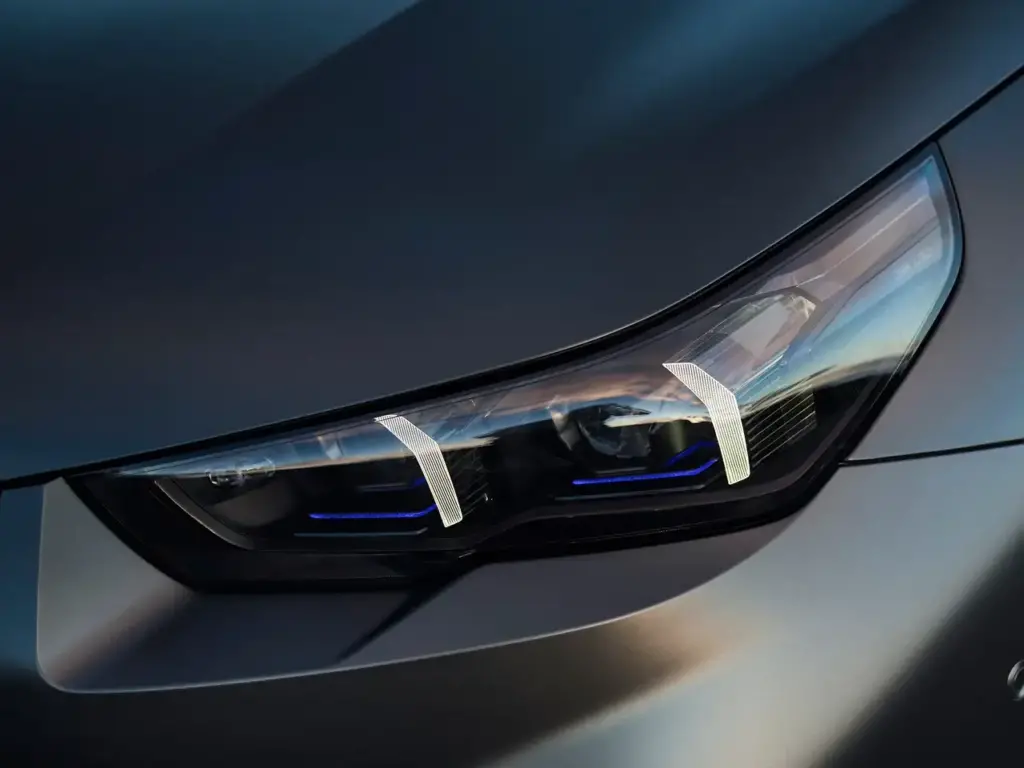
Owner Reviews & Real-World Feedback
What Owners Love About the 2026 M5
According to BMW Blog owner testimony and forum discussions, the top praised features include[4]:
- EV commuting capability: 30-40 miles of electric range eliminates gas usage for daily commutes
- Luxury-performance balance: Comfortable enough for daily use, thrilling when desired
- Quiet cabin refinement: 59 dB in EV mode creates serene driving environment
- Bold design presence: Generates significant attention and compliments
- Technology integration: iDrive 8.5, wireless charging, head-up display work seamlessly
One Chicago-based owner praised the EV mode for stop-and-go traffic, noting it “makes commuting in the M5 actually pleasant”[4].
What Owners Wish Was Different
Common complaints from real owners include[4][5]:
- Overall weight sensation: Noticeable mass on tight, twisty roads
- Missing luxury features: No soft-close doors, rear comfort access at $120k+ price
- Hybrid transition smoothness: 1-2 second lag frustrates some drivers
- Base charger speed: 7.4 kW on 2025 models too slow (resolved for 2026)
- Less visceral experience: Lacks raw, analog feel of previous M5s
A Reddit owner specifically warned potential buyers to thoroughly test the seats, calling them “HORRIBLE” for their comfort preferences[5].
Long-Term Ownership Perspectives
Early adopters with 10,000+ miles report:
- Reliability: No major mechanical issues through initial ownership period
- Maintenance costs: Complimentary coverage handles all scheduled maintenance
- Battery degradation: Minimal capacity loss observed in first year
- Comparison to previous M5: More refined but less engaging than F90 generation
Community Sentiment & Forums
BimmerPost and Reddit discussions reveal mixed sentiment[5]. Enthusiast communities criticize the weight gain and hybrid system complexity, longing for the F90’s purity. However, practical owners who daily drive their M5s appreciate the EV range and refined comfort. Professional reviews from Car and Driver (9.5/10 rating) and MotorTrend emphasize the M5’s balanced execution despite compromises[1][6].
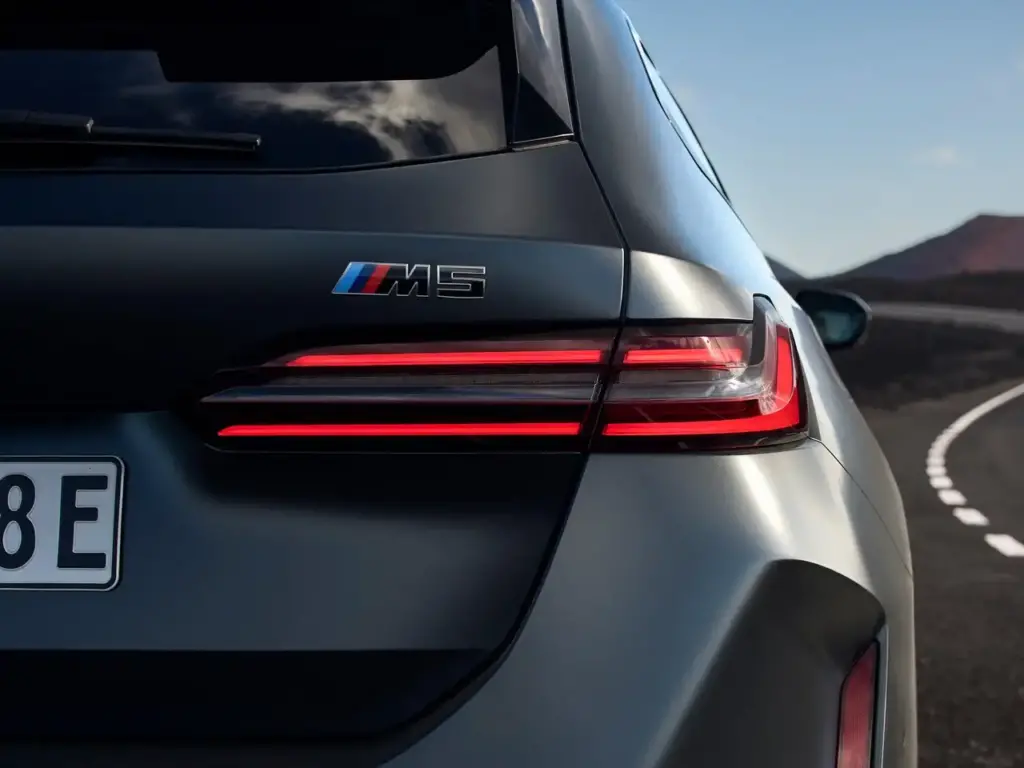
Final Verdict: Should You Buy the 2026 BMW M5?
Who Should Buy This M5
The 2026 M5 excels for:
- Executive buyers prioritizing comfort with performance capability
- Families needing practical super sedan space (especially Touring wagon)
- Tech enthusiasts wanting latest automotive technology
- Daily drivers with occasional track use rather than dedicated track rats
According to Autvex automotive analysis, the M5’s hybrid system delivers genuine real-world benefits for urban commuters, making it more practical than pure performance rivals.
Who Should Look Elsewhere
Consider alternatives if you prioritize:
- Lightweight dynamics: Weight-conscious driving purists should explore the Cadillac CT5-V Blackwing
- Manual transmission: No manual option available (Blackwing offers three pedals)
- Budget constraints: $120k+ pricing excludes budget-focused buyers
- Raw, analog experience: Previous F90 M5 Competition delivers more visceral thrills
15.3 Best Configuration Recommendations
Recommended configuration:
- Body style: Sedan for most buyers, Touring for families needing cargo space
- Must-have packages: Driving Assistance Professional ($1,700), Executive Package ($2,200)
- Consider: M Driver’s Package ($2,500) if you’ll use 190 mph capability
- Skip: Carbon-ceramic brakes ($8,500) unless regular track use planned
- Ideal colors: Storm Bay or Isle of Man Green for resale value
Total recommended configuration: $128,000-$132,000
Buying Strategy & Negotiation Tips
Best purchase timing: Late Q4 2025 or Q1 2026 when dealers face inventory pressure
Negotiation approach:
- Research invoice pricing (typically 6-8% below MSRP)
- Leverage early depreciation data (used examples $20k below MSRP)
- Consider time needed to buy a car and schedule test drives at multiple dealers
- Explore lease options: $1,800-$2,200/month with $10,000 down (36 months)
Lease vs. finance: Given steep first-year depreciation (23-29%), leasing makes financial sense for buyers planning 3-year ownership.
The Bottom Line
The 2026 BMW M5 succeeds as a technological tour de force that balances supercar performance with daily luxury practicality[1][6]. Its 717-hp plug-in hybrid powertrain delivers mind-bending acceleration (0-60 mph in 3.2 seconds) while providing 25-27 miles of emissions-free electric driving—genuinely useful for urban commutes[1][4].
However, the 1,045-pound weight gain fundamentally alters the M5’s character from a razor-sharp sports sedan to a grand touring performance machine[3]. The steering lacks the connection of previous generations, and the chassis can’t fully disguise 5,390 pounds on tight roads[2].
At $120,000-$146,000 fully optioned, the M5 represents strong value against competitors like the $131,000 Audi RS7 Performance, offering more power, electric range, and comparable luxury[1]. For buyers prioritizing technology, refinement, and versatility over pure driving engagement, the 2026 M5 earns its place atop the super sedan segment.
- Autvex Rating: 8.5/10 – Recommended with reservations for weight-conscious enthusiasts.
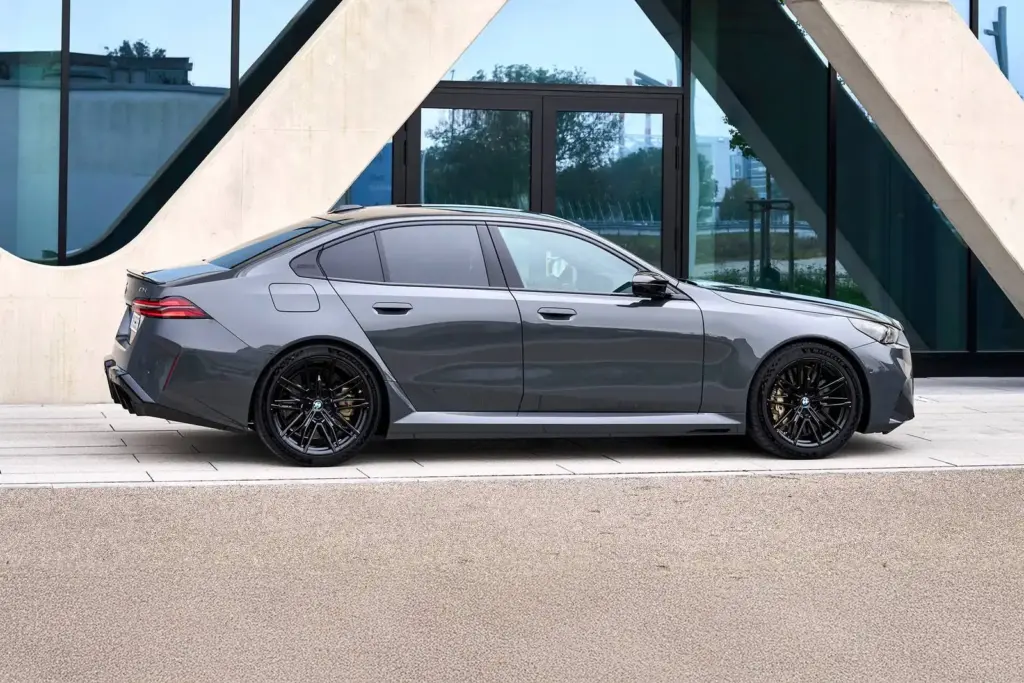
Key Takeaways
- The 2026 M5’s 717-hp hybrid system delivers supercar acceleration (0-60 in 3.2 seconds) with 25-27 miles of usable electric range for daily commutes.
- The 1,045-pound weight gain over the previous generation compromises handling precision and steering feel compared to the F90 M5.
- Starting at $121,000, the M5 offers strong value versus the $131,000 Audi RS7 Performance and Mercedes-AMG E63 S competitors.
- Steep first-year depreciation (23-29%) makes leasing more financially prudent than purchasing for 3-year ownership horizons.
- The hybrid handover lag issue creates 1-2 second hesitations during low-speed acceleration, frustrating some owners awaiting software fixes.
- Track-day costs including tires ($1,600-$2,000 per set) and brake pads ($800-$1,200) add up quickly, especially given the vehicle’s weight and power.
- The M5 Touring wagon’s 57.6 cubic feet of cargo space (seats folded) provides exceptional versatility for performance wagon enthusiasts.
FAQs
Is the 2026 BMW M5 worth $120,000?
Yes, for buyers valuing technology and versatility. The M5’s 717-hp hybrid system, 25-mile electric range, and luxury appointments justify the price against $131,000 Audi RS7 competitors[1]. However, enthusiasts prioritizing lightweight dynamics may prefer the $90,000 Cadillac CT5-V Blackwing.
How much does the 2026 BMW M5 weigh?
The 2026 M5 weighs 5,390 pounds—1,045 pounds heavier than the previous F90 generation[3]. The weight gain comes from the 14.8-kWh battery pack (~485 lbs), electric motor (~220 lbs), and reinforced chassis structure.
What is the electric range of the 2026 BMW M5?
Can the 2026 BMW M5 drift in RWD mode?
Yes, but with difficulty[4]. Activating drift mode requires disabling stability control and selecting 2WD mode. However, the hybrid system and traction controls interfere with traditional burnouts and drifts compared to the more playful F90 generation.
Does the 2026 BMW M5 have hybrid lag issues?
Yes, multiple owners report 1-2 second hesitation when transitioning from electric to gas power at low speeds during aggressive acceleration[5]. Dealer responses vary, with some considering it normal behavior while others acknowledge it as a software calibration issue.
How fast is the 2026 BMW M5 0-60 mph?
What are the main competitors to the 2026 BMW M5?
Primary competitors include the Audi RS7 Performance ($131,195, 621 hp), Mercedes-AMG E63 S (603 hp), Cadillac CT5-V Blackwing ($90,000), and Porsche Panamera Turbo E-Hybrid[1]. The Tesla Model S Plaid offers a full-electric alternative with 1,020 hp.
Is the 2026 BMW M5 good for daily driving?
What’s the difference between the M5 Sedan and Touring?
The Touring wagon offers 27.2 cubic feet of cargo space behind rear seats (57.6 cu ft seats folded) versus the sedan’s 16.5 cu ft[1]. The Touring weighs approximately 100 pounds more and costs $2,000-$3,000 more than the sedan. Performance specifications remain identical.
How reliable is the 2026 BMW M5 hybrid system?
Early reliability appears strong, with 10,000+ mile owners reporting no major mechanical issues[4]. Battery degradation remains minimal through the first year. However, long-term hybrid system reliability remains unproven given the model’s recent introduction.
Should I buy a 2026 M5 or wait for a used one?
Wait for used[1]. A nearly-new 2026 M5 with 200 miles sold for $114,786—$20,000 below its $133,325 MSRP, demonstrating steep initial depreciation. Expect used 2026 models to appear at $105,000-$115,000 by late 2025 with 3,000-5,000 miles.
What’s the fuel economy of the 2026 BMW M5?
The EPA rates the M5 at approximately 20 mpg combined in hybrid mode and 65 MPGe with a full charge[1]. Real-world results show 18-22 mpg in hybrid mode and 12-16 mpg in gas-only spirited driving. Electric-only city driving achieves 60-70 MPGe.
References
- Car and Driver. (2025). 2026 BMW M5 Review, Pricing, and Specs. https://www.caranddriver.com/bmw/m5-2026
- Edmunds. (2025). 2026 BMW M5 Prices, Reviews, and Pictures. https://www.edmunds.com/bmw/m5/
- BMW Blog. (2025). BMW Explains Why The New M5 Is A Hybrid. https://www.bmwblog.com/2025/05/26/bmw-explains-why-m5-hybrid/
- BMW Blog. (2025). The Top 5 Things I Love—and Don’t Love—About the New BMW M5. https://www.bmwblog.com/2025/05/01/bmw-m5-g90-review-pros-cons/
- Reddit. (2025). Acceleration lag issue with 2026 M5 Hybrid. r/BMW. https://www.reddit.com/r/BMW/comments/1n6qik8/acceleration_lag_issue_with_2026_m5_hybrid/
- Isringhausen BMW. (2025). 2026 BMW M5. https://www.isringhausenbmw.com/blog/2026-m5

I am a senior automotive analyst at Autvex. Expert vehicle evaluations, in-depth reviews, and objective analysis helping readers make informed automotive decisions with years of industry experience.

